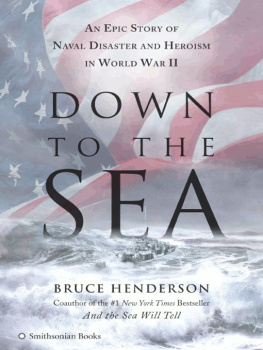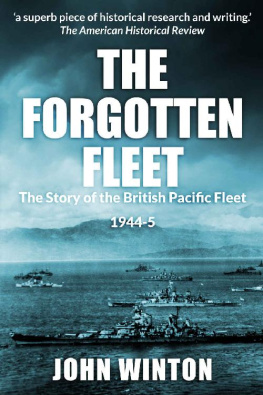A BOARD THE DESTROYER S PENCE
IN THE WESTERN P ACIFIC
December 18, 1944
It was shortly after 11:00 A.M. when Water Tender 3rd Class Charles Wohlleb of West New York, New Jersey, left the after fire room and headed topside. He did so with two shipmates also not on watch that morning: Water Tender 3rd Class Cecil Miller and Boilermaker 1st Class Franklin Horkey. The three sailors had gone down to the fire room where there was always a pot of coffee brewing, but they found the crowded space too uncomfortable with the ship pitching and rolling in mountainous seasthe worst storm any of them had ever been through. Before they left, Horkey put on a sound-powered phone headset and told the men who remained at their duty stations that he would let them know what was happening topside. They climbed a ladder and went through a hatch to reach the main deck.
Wohlleb, a shy, soft-spoken twenty-year-old who after high school had worked in the Civilian Conservation Corps before receiving his draft notice and thereafter enlisting in the Navy in January 1943, would never forget the names and faces of the four men he last saw attending to their assigned duties that morning in the fire room. Standing atop the narrow steel platform in front of the control panel of the Babcock and Wilcox oil-fired boiler, Water Tender 2nd Class Frank Thompson operated the oil burners that fed the fire inside the firebox. Fireman 1st Class Norman Small, a Nebraska farm kid who was not small, kept a close eye on the fuel-oil heater and pressure gauges. Fireman 1st Class Claude Roy Turner monitored the water levels and adjusted a valve whenever necessary to keep the right amount of water circulating through copper tubes above the boiler to ensure the generation of sufficient steam to drive the two General Electric geared turbines that powered the ship. Water Tender 1st Class Layton Slaughter, who was in charge, wore sound-powered phones in order to communicate with Horkey. Slaughter controlled the amount of air that went into the boiler and the color of smoke that came out the stack. In a war zone, releasing black smoke (not enough air in the boiler) was an unsafe proposition, as it could pinpoint the vessels location to enemy warships and aircraft from miles away. As usual, no one on the black gangso called from the days of coal-burning ships, when soot habitually stained the faces, hands, and clothing of men who worked in the fire roomwas wearing a life preserver. The spaces where they worked were very hot, at times as much as 130 degrees, and they also wanted to be able to move around freely.
When Wohlleb and the other two sailors reached topside, they emerged under an alcove that blocked most of the howling wind and rushing seawater swamping the deck. Their protected location was fortuitous, as no one could have stayed in the open for long without being swept overboardexactly why earlier that morning all hands not on duty had been ordered to remain in the berthing compartments two or more levels below the main deck. During heavy weather, men not on watch typically climbed into their rackswhether they could sleep or notand braced themselves to keep from being thrown around.
There was no visible horizon; the driving rain and blowing spray obscured where the sea ended and the sky began. From this swirling, grayish spume a colossal wall of seawater, taller than the ships 50-foot mast, emerged off the bow every twenty or thirty seconds. The destroyer was riding unusually high in the water due to being dangerously low on fuel, bobbing in the turbulent seas like a childs bath toy. Each time Spence ascended up another wall of water, she was inundated at the crest, where she teetered briefly before pitching forward. On the thunderous ride downhill, the ship rocked, rolled, and yawed precariously. Once at the bottom of the trough, Spence heeled steeply in the driving winds until the next onslaught.
Wohlleb and his companions watched in horror as a depth charge packed with 200 pounds of torpexan explosive 50 percent more powerful than TNT by weightbroke loose from its rack nearby, skipped across the deck, and slammed into bulkheads before washing overboard. An acetylene tank broke loose and did the same precarious dance across the deck before taking flight in the wind.
Over the headsets, Horkey was receiving news from below. Jesus! he yelled, his voice sounding muted and far away. After fire roomswamped!
Wohlleb knew what that meant: seawater had gone down the stacks and probably also the fresh-air ventilators that went from the main deck to the fire room. Pumping would have to commence immediately to stop the rising water from shorting out the electric panels in the fire room and adjacent engine room, which could mean the loss of lights, power, steeringleaving Spence , a 2,100-ton Fletcher -class destroyer with a crew of 339 men, dead in the water.
Not more than a minute later, Horkey yelled: Control boardson fire!
Right up until that moment, Wohlleb had given no thought to the ship sinking. He and the veteran crew had gone through too much together to worry about a storm. Over a fifteen-month period they had been in some of the toughest naval action yet seen in the Pacific, for which Spence had earned eight battle stars. They had come through their encounters with the Imperial Japanese Navy unscathed. Indeed, throughout the U.S. Third Fleet, Spence had a reputation for being not only a stalwart fighting ship but also a very lucky one.
Lights out below! Losing power!
Spence s run of good fortune was about to end.
December 7, 1941
The greatest generations first day of war dawned bright over Oahu.
Although sunrise came officially to the Hawaiian Islands at 6:36 A.M. that morning, Pearl Harbor remained shaded to the east by the 2,000-foot volcanic twins, Tantalus and Olympus, for another half an hour. As the sun crested the low-slung mountaintops, its brilliance washed the sky with bold streaks of light and painted in emerald the endless sugarcane fields stretching up the lush slopes above the nearly landlocked home port of the U.S. Navys Pacific Fleet.
The destroyer Monaghan (DD-354) was tied up to a nest of three other destroyers: Aylwin , Dale, and Farragut . The four vessels, which made up Destroyer Division 2, were moored side by side in East Loch off the north end of Ford Islandless than one square mile of land situated in the middle of Pearl Harborhome to a naval air station, warehouses, and oil storage tanks. Several dozen other ships, including three other destroyer divisions, were moored on that side of the island; however, most of the fleets anchorages (including an impressive lineup of Americas biggest warships on Battleship Row), dry docks, and repair facilities, along with a sprawling oil-tank farm, were located along the harbors expansive southeastern shores.
Monaghan had been the ready-duty destroyer since 8:00 the previous morning, meaning that for twenty-four hours the ship was in readiness to get under way on one hours notice should her presence be required outside the harbor. To ensure a quick getaway, Monaghan was moored in the outboard position of the nest and singled up (with only one mooring line rather than multiple tie-downs), with a fire under one boiler and the full crew aboard. In the event of hostilities, enemy submarines were believed to be the most serious threat to the flow of ships that came and went from the harbor, so there was always at least one destroyer patrolling outside the entrance. Another destroyer was on standby to assist with any emergency outside the harbor.













